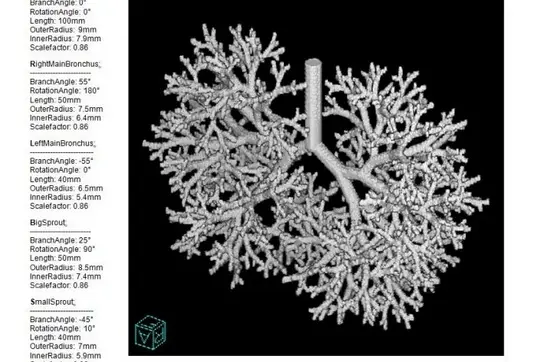Lung Phantom
Marc Kachelrieß
The aim of this phantom is to provide semi–antropomorphic cone–beam rawdata for CT–angiography and –bronchoscopy.
Phantom Description
The Lung Phantom is a fractal model of the bronchial tree which has been described first in [1]. Each branch of the Lung Phantom consists of a hollow cylinder with a hollow half–sphere at each end. Out of one end of the branch grow two sprouts, a small and a big one. The plane in which lie the two sprouts is the so–called branch plane. The branch plane is rotated from generation to generation by a given angle to extent the structure from two to three dimensions and thus to homogeneously fill a given volume (the lung).
The phantom structure can mathematically be modelled as a L–System (Lindenmayer System). It consists of the starting axiom
T[L[s][b]][R[s][b]]
and the simultaneous substitutions
b B[b][s]
s S[b][s].
Substituting n-2 times yields a bronchial tree of up to the n –th generation since already generations 0, 1 and 2 are included in the axiom. The result of the substitutions is the so–called product. Capitalized symbols are the terminal symbols. They will not be substituted anymore. For example the product for n-4 is
T[L[S[B][S]][B[B][S]]][R[S[B][S]][B[B][S]]]
where the remaining active symbols have been capitalized after the last substitutions to yield terminal symbols only. Each terminal symbol represents one of the following branch objects used to build the lung:
The BranchAngle determines the angle between the current branch and the new sprout. The RotationAngle describes the rotation of the branch plane after the new sprout has been added. Length obviously gives the length of the branch and OuterRadius as well as InnerRadius give the radii of the branch. The most important feature is the Scalefactor which determines how to scale the dimensions of the branch from generation to generation: If k is the number of the generation considered (0 ≤ k ≤ n) then its dimensions will be multiplied by Scalefactor ѱ.
The number of branch objects used to build the lung is given by 2ѱ+1-1 . Nevertheless, as each branch object will be modeled by two cylinders and two spheres at the lower end (the spheres at the upper end can be left away since they completely lie within the mother branch of the last generation before) with radius OuterRadius and InnerRadius the complete lung will be made of 4(2ѱ+1-1) basic objects.
Currently the phantom is designed to be monochromatic. The wall of each branch has the density of water, the airways have a density of 10% water.
The program does not check for a self–penetration of the lung yet.
[1] Markus Blank. Untersuchungen zur Morphologie der Lunge anhand Spiral–CT–Daten. Dissertation, Friedrich–Alexander–Universität Erlangen–Nürnberg, May 1998.
Files
